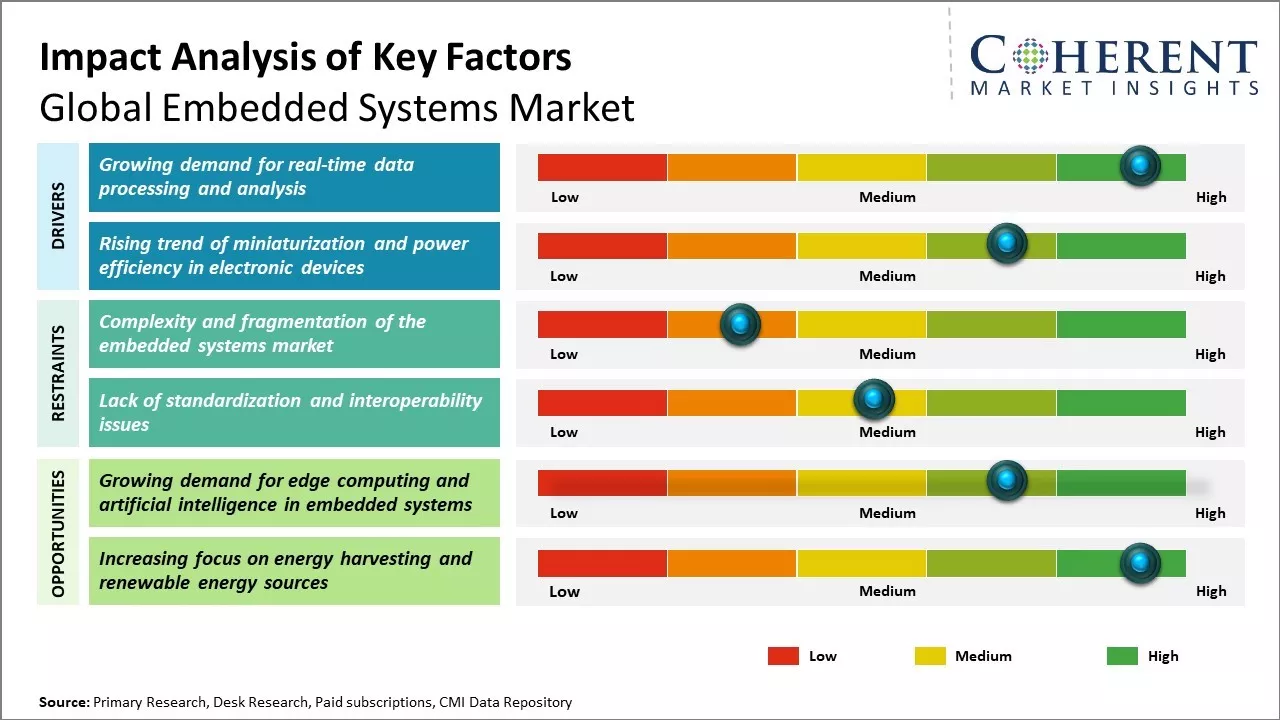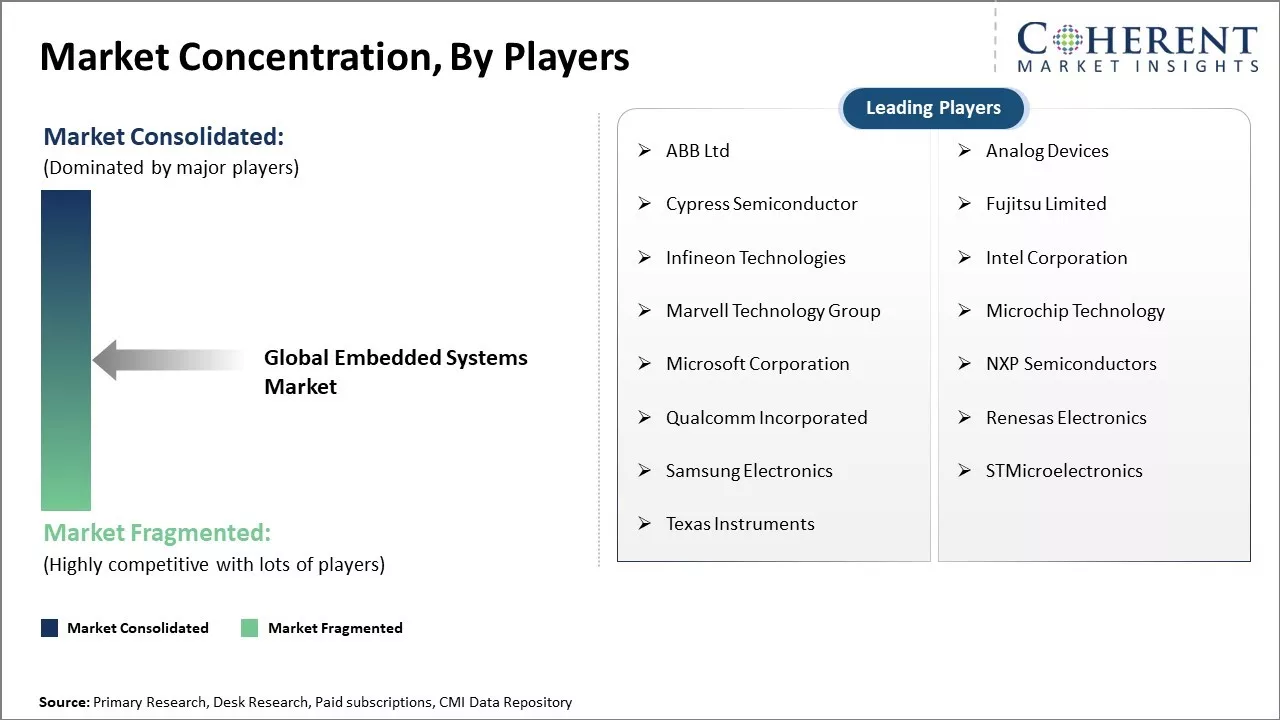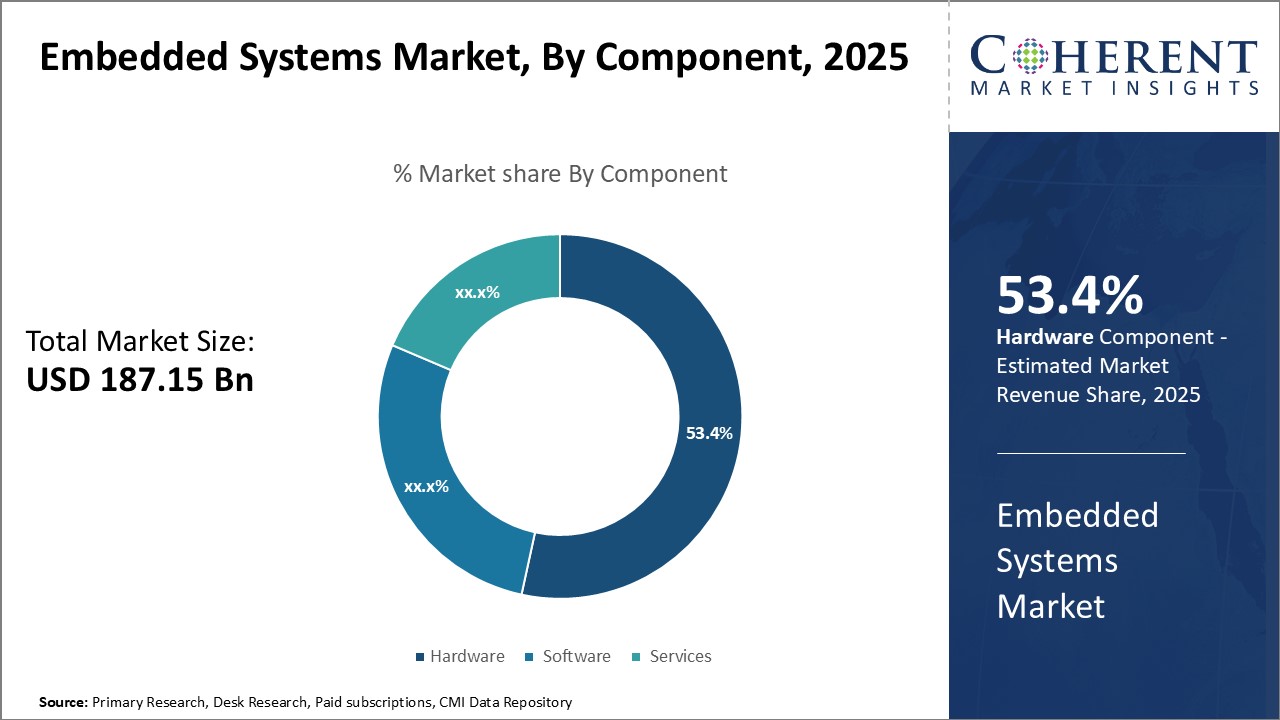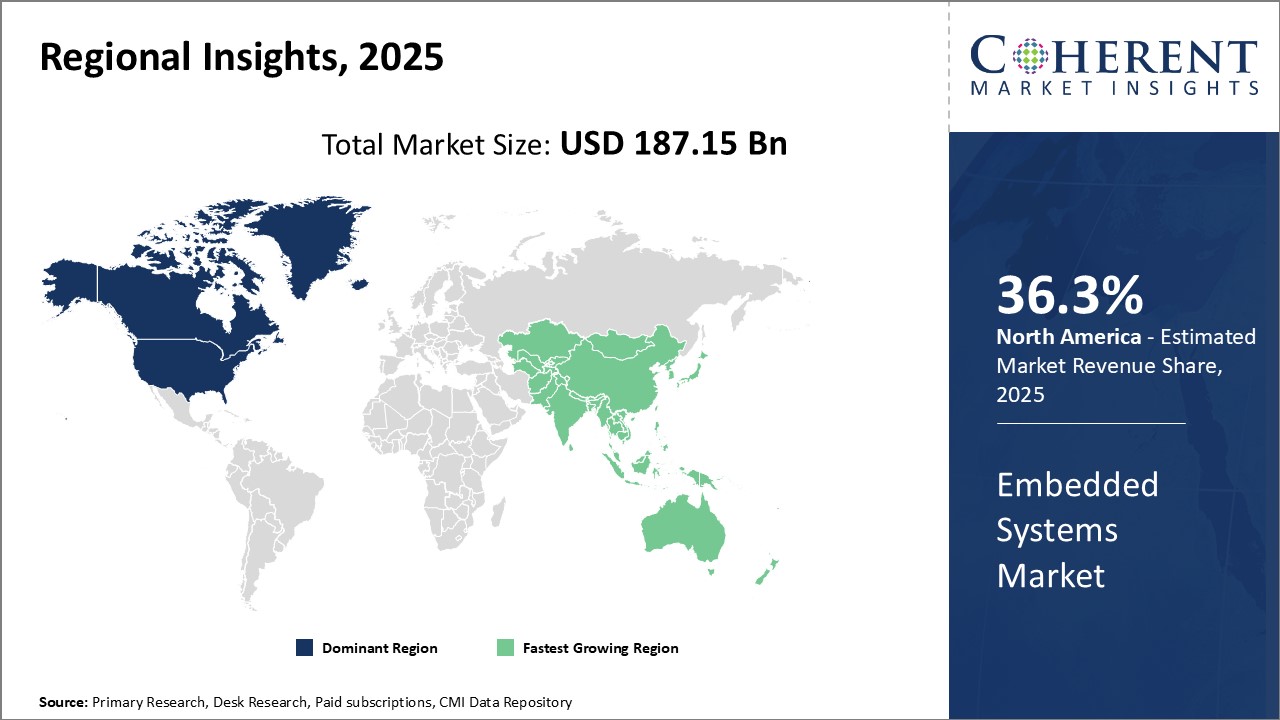The global embedded systems market is estimated to be valued at USD 174.24 Bn in 2024 and is expected to reach USD 283.12 Bn by 2031, exhibiting a compound annual growth rate (CAGR) of 7.2% from 2024 to 2031.

To learn more about this report, request sample copy
The Global Embedded Systems Market is witnessing significant growth owing to the increasing Internet of Things (IoT) penetration and rising demand for software-based systems from various end-use industries such as automotive, healthcare, industrial automation, and consumer electronics.
The global embedded systems market trend shows a rising demand for systems-on-chip in applications such as smart grids, wearable devices, and industrial machines. Furthermore, emerging technologies in embedded systems such as artificial intelligence (AI), machine learning, and deep learning are creating opportunities for market players to develop innovative products and solutions. Processors with higher efficiency and lower power consumption compatible with emerging technologies will drive the future growth of the embedded systems market.
Growing demand for real-time data processing and analysis
Today's world has become very fast paced and dynamic in nature. With each passing second, there is a massive amount of data that is being generated from various sources across industries and domains. This data holds tremendous value and insights that organizations want to leverage for decision making, optimization of processes, gaining competitive advantage and much more. However, to unlock the true potential of data, it is important that the data collected is processed and analyzed in real-time as fast as possible.
With the proliferation of IoT devices, connected machines and sensors, the ability to collect and generate data in real-time has increased manifold over the past few years. Be it manufacturing plants that want to monitor production lines and assembly processes, autonomous vehicles that need real-time situational awareness, health monitors that analyze vital body signals, entertainment devices that recognize user inputs instantaneously or smart cities installed with various monitoring systems - they all rely on real-time data insights. However, traditional systems and architectures lacked the capability for low-latency, fast response times required for mission critical and time-sensitive applications. Embedded systems with their compact size and high-performance processors have emerged as the ideal solution to tackle such challenges.

Get actionable strategies to beat competition: Get instant access to report
Rising trend of miniaturization and power efficiency in electronic devices
With growing affordability and accessibility, consumer electronics have become ubiquitous in today's world. Be it smartphones, wearables, smart home devices, appliances or entertainment systems - electronics are increasingly becoming integrated into daily lives. However, the continuous rise in the level of integration, functionality, and performance poses design challenges for original equipment manufacturers. There is constant pressure to pack more features into smaller footprints while also optimizing for longer battery lives. At the same time, users also expect sleeker, more portable devices without comprising on functionality. This has accelerated the trend of reduction in form factor and power consumption across consumer electronics.
Embedded systems have played a pivotal role in enabling miniaturization through their small size, low-power processor technologies and ability to custom design for specific applications. Original design manufacturers find embedded solutions that tightly integrate various components like sensors, connectivity, memory, processing, etc. into tiny packages. This has allowed the industry to build innovative devices like hearables, smartwatches, advanced digital cameras, miniature medical devices, and others. Ongoing advancements in semiconductor manufacturing processes are further driving the ability to develop even smaller and more powerful embedded boards, system on chips and modules. Their tight integration helps consolidate functionalities into minimum possible footprints.
Key Takeaways from Analyst:
The global embedded systems market is poised to grow significantly over the coming years. Drivers such as the rising demand for industrial automation and government mandates on safety systems will boost market revenues. Further, the robust growth of the automotive industry and incorporation of complex digital networks in modern vehicles will drive embedded systems adoption. Growth opportunities also exist in developing applications for the IoT and connected devices space.
However, high manufacturing costs and intellectual property issues limit the widespread use of embedded systems in some regions. Design complexities associated with advanced technologies pose challenges as well. Lack of in-house expertise prevents small enterprises from implementing embedded solutions. Furthermore, security vulnerabilities impact the large-scale deployment of embedded platforms connected to the internet.
Moving forward, North America is likely to dominate the embedded systems market owing to considerable investments in R&D by major players. The Asia Pacific region, especially China, is projected to see the fastest growth on account of increasing electronics production and low-cost manufacturing centers. The flourishing automotive, industrial, and consumer electronics sectors in developing Asian economies will catalyze market revenues. European nations are also emerging as major innovation hubs for embedded technologies.
Market Challenge - Complexity and fragmentation of the embedded systems market
The global embedded systems market is highly complex and fragmented due to the presence of various components, software, and platforms used across different end-user industries. There are millions of microprocessors used in a varied range of embedded systems with different form factors, capabilities, and operating environments. Additionally, various operating systems such as Linux, Windows, and real-time operating systems are used based on the application requirements. This level of variation leads to interoperability issues and makes it difficult for vendors to build unified solutions. Furthermore, the lack of standardization in platforms and software increases integration challenges for end users. Managing updates and security patches also becomes an arduous task due to the presence of different processor families and board-level customizations. Overall, the complexity and fragmentation in the embedded systems market hampers innovation, drives up development costs, and negatively impacts customer experience.
Market Opportunity - Growing demand for edge computing and artificial intelligence in embedded systems
The growing demand for edge computing and artificial intelligence capabilities in embedded systems is opening up significant opportunities for market players. With the proliferation of IoT networks and connected devices, there is an increasing need to process data locally and perform real-time analytics at the edge to reduce latency. This factor is driving up the demand for powerful embedded systems equipped with AI processors, neural network accelerators, and advanced algorithms. OEMs across industries are opting for embedded AI edge devices to enable advanced automation, predictive maintenance, computer vision and VR/AR applications. Additionally, the ability to deploy AI models over extended periods with minimal network connectivity is fueling the need for enhanced on-device processing. Leading embedded vendors are well positioned to leverage this opportunity by offering customized edge computing solutions embedded with best-in-class AI capabilities.

Discover high revenue pocket segments and roadmap to it: Get instant access to report
Insights By Component - Economies of Scale Drive Hardware Dominance
In terms of component, hardware is expected to contribute 52.9% share of the global embedded systems market in 2024 owing to bulk standardization opportunities. Embedded hardware forms the core building blocks across a wide variety of end use products and applications. Being an integral piece of electronic devices, embedded hardware sees massive volumes of production runs each year. This allows hardware manufacturers to significantly benefit from economies of scale during the manufacturing process. Standardizing chipset and component designs enables optimizations across the supply chain from procuring raw materials to production assembly. Bulk orders directly translate to lower per-unit production costs.
Additionally, hardware benefits from a simpler product life cycle compared to software and services. Once a processor or module design is finalized, minimal ongoing innovation is required to continue mass production. This allows harnessing scale advantages over a longer duration for each hardware generation before a redesign. In contrast, software requires constant upgrades and customizations. Even commodity hardware sees brisk demand replacement cycles as new devices are introduced in the market. Established hardware players have also vertically integrated their operations to capture more value from design to finished goods.
Although initial investments into fabrication plants and machinery are capital intensive, amortizing costs over high volume runs ensures healthy margins. Leading firms such as ABB Ltd, Analog Devices, Cypress Semiconductor, Fujitsu Limited, Infineon Technologies, etc. continuously invest in next-generation fabs and production technologies to maintain their scale edge. Hardware also has less stringent localization needs compared to other segments. Standard parts can be efficiently manufactured in global export hubs and distributed worldwide. This global supply chain integration further drives down hardware costs, cementing its top position in the embedded systems component landscape.
Insights By Type - Proliferation of Standalone Applications Boosts Individual Hardware Demand
In terms of type, standalone embedded systems is expected to contribute 37.3% of the market share in 2024 owing to the proliferation of individual embedded applications across end-use industries. Standalone systems comprise a complete microprocessor and peripheral components packaged into a single chip or module without any additional hardware. They are self-contained with dedicated functions and operate independently of any other device.
The rapid expansion of the Internet of Things (IoT) has seen unprecedented growth in standalone sensors, controllers and single-use devices embedded into various machines, infrastructure and everyday products. Use cases include smart home appliances, industrial automation equipment, building automation, infrastructure monitoring nodes, medical instrumentation, inventory tracking tags and many more. As standalone nodes can serve highly focused individual applications, IoT architecture is built upon networks of discrete embedded systems.
Furthermore, industries are embedding intelligence directly into their products to enhance functionality and create new revenue streams. This has led to a surge in standalone systems-on-chip tailored for specific product needs. Examples include embedded control modules built into vehicles, specialized diagnostics equipment, single-purpose wearables and handheld diagnostic tools. Such productized embedded systems add self-contained capabilities without imposing dependencies on external infrastructure.
Insights By End User - Growth of Connected Products Drives Demand Across the Automotive Vertical
In terms of end user, the automotive segment is expected to contribute 40.8% share to the embedded systems market in 2024 owing to the proliferation of connected vehicles and advanced driver assistance systems. Modern cars integrate dozens of embedded systems to control engine, stability, infotainment, navigation and safety-critical functions. The automotive industry is undergoing a shift towards vehicle connectivity and autonomy.
Vehicle networking is enabling novel telematics, fleet management and usage-based insurance models. This has spurred automakers to embed robust network controllers, gateways and edge computing capacities into their offerings. Connected car services require high-speed reliable embedded communication hardware, software stacks and edge analytics suites integrated seamlessly into automotive IT architectures.
At the same time, growing demand for assisted and self-driving technologies is driving rapid change. Advanced Driver Assistance Systems (ADAS) rely extensively on embedded artificial intelligence, computer vision, radar and sensor fusion systems. Emerging autonomous driving architectures mandate high-performance embedded hardware acceleration alongside dedicated security and safety-critical software to monitor critical vehicle functions.
As such, automotive has emerged as early adopters of the newest embedded technologies due to performance, safety and integration needs of modern vehicle systems. Steep innovation and embedded deployment cycles within automotive far outpace other verticals. The segment is also aggressively investing in collaborative transportation platforms relying on vehicle-to-vehicle, vehicle-to-infrastructure and vehicle-to-cloud embedded capabilities. Such factors have positioned automotive at the forefront of embedding intelligence and connectivity across its product portfolio, cementing its dominance in the end-user landscape.
In October 2023, Infineon Technologies AG, a global leader in semiconductor solutions, partnered with Eatron Technologies, a fast-growing technology company dedicated to unlocking the full potential of batteries with intelligent software. The collaboration aimed to integrate advanced machine learning solutions and algorithms into Infineon's AURIX TC4x microcontroller (MCU) family, with the goal of advancing automotive Battery Management Systems (BMS). By leveraging the state-of-the-art machine learning capabilities of the AURIX TC4x MCU, including its integrated parallel processing unit (PPU), Eatron is able to maximize the performance and accuracy of its AI-powered battery management software.

To learn more about this report, request sample copy
The North America region currently dominates the global embedded systems market. The region is expected to hold 35.8% of the market share in 2024. Several factors have contributed to North America's leading position. With countries like the U.S. and Canada, the region is home to many large enterprises and technology giants developing next-generation embedded solutions. It has a sizable semiconductor industry and major embedded systems product developers. North American manufacturers are also early adopters of advanced embedded technologies across sectors like automotive, industrial automation, and medical devices.
Support from government has helped North America emerge as a hub for embedded systems innovation. Several universities and research facilities are actively involved in next-gen embedded technology research and development. This strong coupling between academia and industry has led to rapid product development and commercialization of novel embedded concepts. North American companies also have a strategic focus on sophisticated embedded hardware and software engineering capabilities. Their embedded solutions cater to mission-critical applications demanding high reliability and performance.
The Asia Pacific region, led by countries such as China, Japan, South Korea, and others, is witnessing the fastest growth in the embedded systems market. Asia Pacific has emerged as a global manufacturing powerhouse with a large production-linked domestic market and competitive manufacturing and labor costs. This makes embedded systems an integral part of various goods manufactured in Asia Pacific , from consumer electronics and appliances to industrial machines. The growing middle-class population and their rising disposability incomes in Asia Pacific also boosts the demand for smarter embedded devices.
Asia Pacific is witnessing heavy investments from global embedded leaders setting up regional design and manufacturing centers. This establishes local product development and support infrastructure. Additionally, governments in several Asian countries actively promote the adoption of embedded technologies across priority sectors by offering funding, tax benefits, and other incentives. Such supportive policy initiatives are driving the Asia Pacific region to become an electronics manufacturing and embedded innovation powerhouse of the future. For instance, o In July 2023, Microchip Technology Inc., a leading provider of smart, connected, and secure embedded control solutions, announced plans to invest approximately US$ 300 million to expand its operations in the Indian embedded systems market over the next few years. The investment will focus on enhancing its facilities in Chennai and Bangalore in India, as well as establishing a new research and development center in Hyderabad, India. This initiative aims to bolster Microchip's presence in India, where it currently employs around 2,500 people across various locations.
Embedded Systems Market Report Coverage
| Report Coverage | Details | ||
|---|---|---|---|
| Base Year: | 2023 | Market Size in 2024: | US$ 174.24 Bn |
| Historical Data for: | 2019 To 2023 | Forecast Period: | 2024 To 2031 |
| Forecast Period 2024 to 2031 CAGR: | 7.2% | 2031 Value Projection: | US$ 283.12 Bn |
| Geographies covered: |
|
||
| Segments covered: |
|
||
| Companies covered: |
ABB Ltd, Analog Devices, Cypress Semiconductor, Fujitsu Limited, Infineon Technologies, Intel Corporation, Marvell Technology Group, Microchip Technology, Microsoft Corporation, NXP Semiconductors, Qualcomm Incorporated, Renesas Electronics, Samsung Electronics, STMicroelectronics, and Texas Instruments |
||
| Growth Drivers: |
|
||
| Restraints & Challenges: |
|
||
Uncover Macros and Micros Vetted on 75+ Parameters: Get Instant Access to Report
*Definition: The global embedded systems market consists of companies that design and market embedded systems to be used in various sectors globally. Embedded systems are specialized computer systems designed for specific control functions within equipment like motor vehicles, medical devices, communication devices, and industrial equipment. They typically include a microprocessor with programming stored in ROM or flash memory. This market includes hardware, software tools, and development platforms used to design and develop embedded systems.
Share
About Author
Pooja Tayade
Pooja Tayade -is an experienced management consultant with a strong background in the Semiconductors and Consumer Electronics industries. Over the past 9 years, she has helped leading global companies in these sectors optimize their operations, drive growth, and navigate complex challenges. She He has led successful projects that delivered significant business impact, such as: Facilitating international expansion for a mid-sized tech enterprise, navigating regulatory compliance in 4 new countries and growing foreign revenue by 50% Implementing lean manufacturing principles that reduced production costs by 15% for a major semiconductor fab
Missing comfort of reading report in your local language? Find your preferred language :
Transform your Strategy with Exclusive Trending Reports :
Frequently Asked Questions
Joining thousands of companies around the world committed to making the Excellent Business Solutions.
View All Our Clients